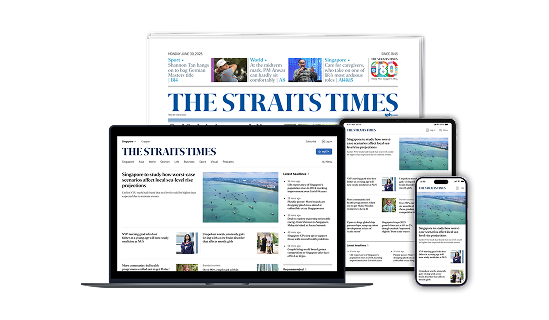What just happened? Making sense of Trump’s tariff pause
Sign up now: Get ST's newsletters delivered to your inbox

The unpredictability of the Trump administration makes it impossible to say what happens when the 90-day pause ends.
PHOTO: ERIC LEE/NYTIMES
Follow topic:
NEW YORK - For weeks, US President Donald Trump has ploughed ahead with plans to impose steep new tariffs on imports, despite warnings that the policy could trigger economic chaos. On April 9, after a multi-day plunge in global stock markets, he changed course.
In a social media post, Mr Trump said that a set of tariffs on imports from many of America’s largest trading partners were paused.
The announcement came only 13 hours after the duties had gone into effect.
The President indicated that turmoil in the financial markets following the implementation of the tariffs played a role in his decision. Here are some key points.
What tariffs did Trump pause?
President Trump announced a 90-day pause
The tariffs were customised to each trading partner and corresponded to the size of their trade surplus with the United States.
Imports from those trading partners will now be subject instead to the flat duty of 10 per cent that Mr Trump placed on goods arriving from all foreign countries starting from April 5.
China, one of the countries subject to the reciprocal tariffs, was not included in the pause.
Instead, Mr Trump announced that he would increase levies on Chinese goods to 125 per cent from 104 per cent.
His decision came after Beijing announced plans to retaliate with an 84 per cent duty
In his post on April 9, Trump said that other countries subject to the tariffs “have not, at my strong suggestion, retaliated in any way, shape, or form”.
Why did Trump pause some tariffs?
The implementation of the reciprocal tariffs caused market turmoil and stoked recession fears.
Mr Trump came under massive pressure from business leaders and investors to reverse course.
“I thought that people were jumping a little bit out of line,” Mr Trump told reporters at the White House when asked why he backed off. “They were getting a little bit yippy, a little bit afraid.”
What happens when Trump’s pause ends?
The unpredictability of the Trump administration makes it impossible to say.
Mr Trump’s post announcing the pause suggested that its purpose is to give US trading partners an opportunity to strike deals to avoid the tariffs.
Mr Trump and other US officials have said they want countries to take measures that include reducing their own tariffs as well as other barriers to trade, which could include regulations, quotas, subsidies to domestic producers, and insufficient protection of intellectual property.
Mr Trump argues that the US trade deficit is a result of barriers to trade and wants to eliminate it.
It is possible that when the 90-day pause ends in early July, countries that have not negotiated a deal with the US will again face the tariffs that were briefly imposed on April 9.
Mr Trump could also announce another deferment.
He twice delayed the imposition of tariffs on some imports from Mexico and Canada.
What’s the situation for Canada and Mexico?
America’s two largest trading partners were not subject to the reciprocal tariffs.
Rather, goods from Canada and Mexico face 25 per cent tariffs that Mr Trump has tied to illegal drugs and unauthorised immigrants coming across US borders.
However, imports that are covered by a North American free trade agreement are exempt.
What was the stock market reaction to the tariff pause?
Stocks soared following Mr Trump’s announcement of a pause on some tariffs.
The S&P 500 jumped 9.5 per cent, the index’s biggest single-day leap since 2008.
The latest moves cap a week of turmoil that began when Mr Trump shocked the world by announcing that he was imposing the highest US tariffs in more than a century.
Oil prices, which had slid in recent days on fears of a global economic slowdown, also rallied on the latest news.
Is the US heading into a recession?
It had started to look that way before Mr Trump’s announcement of the pause.
The decision to impose tariffs, unveiled by Mr Trump on April 2, weighed on the already deteriorating mood of consumers, and Wall Street banks had raised the odds of a global recession in 2025.
Analysts said the prospect of higher prices and increasingly cautious business activity would dent economic growth and possibly cause the economy to contract.
The stock market’s surge in the aftermath of Mr Trump’s pledge to pause some tariffs came as a relief to many on Wall Street, and the news prompted economists at Goldman Sachs Group to rescind their recession forecast.
But deep uncertainty surrounding Mr Trump’s next move, combined with the impact of tariffs that for now remain in effect, including the steep levies on imports from China, have left many corporate leaders and investors nervous.
The economy will remain under pressure if those jitters lead to a substantial pullback in spending.
Why is China the main target of Trump’s tariffs?
Mr Trump’s argument that China’s trade practices are unfair predates the country’s announcement that it would retaliate against US reciprocal tariffs.
He first increased tariffs on imports from the world’s second-biggest economy in his first term as president. In his second term, he has signed executive orders that suggest tariffs are a way to hold China accountable for its alleged failure to curb the export of fentanyl and its precursor chemicals, which have contributed to the US opioid crisis. BLOOMBERG

